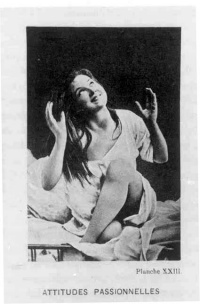Madwoman
From The Art and Popular Culture Encyclopedia
| Revision as of 17:45, 26 December 2020 Jahsonic (Talk | contribs) ← Previous diff |
Revision as of 17:59, 26 December 2020 Jahsonic (Talk | contribs) Next diff → |
||
| Line 1: | Line 1: | ||
| {| class="toccolours" style="float: left; margin-left: 1em; margin-right: 2em; font-size: 85%; background:#c6dbf7; color:black; width:30em; max-width: 40%;" cellspacing="5" | {| class="toccolours" style="float: left; margin-left: 1em; margin-right: 2em; font-size: 85%; background:#c6dbf7; color:black; width:30em; max-width: 40%;" cellspacing="5" | ||
| | style="text-align: left;" | | | style="text-align: left;" | | ||
| - | "When the imprisoned [[Marquis de Sade]] was denied “any use of pencil, ink, pen, and paper,” declares Roland Barthes, he was figuratively emasculated, for “the scriptural sperm” could flow no longer, and “without exercise, without a pen, Sade [become] ''bloated'', [became] a eunuch."--''[[The Madwoman in the Attic]]'' (1979) by Sandra Gilbert and Susan Gubar, citing ''[[Sade, Fourier, Loyola|Sade/Fourier/Loyola]]'' (1971) by Barthes | + | "As if to comment on the unity of all these points—on, that is, the anxiety inducing connections between what [[women writers]] tend to see as their parallel confinements in texts, houses, and maternal female bodies—[[Charlotte Perkins Gilman]] brought them all together in 1890 in a striking story of female confinement and escape, a paradigmatic tale which (like ''[[Jane Eyre]]'') seems to tell the story that all literary women would tell if they could speak their “speechless woe.” “[[The Yellow Wallpaper]],” which Gilman herself called “a description of a case of [[nervous breakdown]],” recounts in the first person the experiences of a woman who is evidently suffering from a severe [[postpartum psychosis]]."--''[[The Madwoman in the Attic]]'' (1979) is a book by Sandra Gilbert and Susan Gubar |
| <hr> | <hr> | ||
| "Here comes the [[madwoman]], dancing, while she dimly remembers something." --''[[Les Chants de Maldoror]]'' (1869) by Comte de Lautréamont, translated by [[Alexis Lykiard]] | "Here comes the [[madwoman]], dancing, while she dimly remembers something." --''[[Les Chants de Maldoror]]'' (1869) by Comte de Lautréamont, translated by [[Alexis Lykiard]] | ||
Revision as of 17:59, 26 December 2020
|
"As if to comment on the unity of all these points—on, that is, the anxiety inducing connections between what women writers tend to see as their parallel confinements in texts, houses, and maternal female bodies—Charlotte Perkins Gilman brought them all together in 1890 in a striking story of female confinement and escape, a paradigmatic tale which (like Jane Eyre) seems to tell the story that all literary women would tell if they could speak their “speechless woe.” “The Yellow Wallpaper,” which Gilman herself called “a description of a case of nervous breakdown,” recounts in the first person the experiences of a woman who is evidently suffering from a severe postpartum psychosis."--The Madwoman in the Attic (1979) is a book by Sandra Gilbert and Susan Gubar "Here comes the madwoman, dancing, while she dimly remembers something." --Les Chants de Maldoror (1869) by Comte de Lautréamont, translated by Alexis Lykiard |

|
Related e |
|
Featured: |
A madwoman is a woman who is insane.
Contents |
In fiction
- The Yellow Wallpaper by Charlotte Perkins Gilman
- Rochester's mad wife Bertha who stays locked in the attic in Jane Eyre
In art
- Head of a Woman (Delacroix)[1], 1822 painting, Eugène Delacroix, sometimes called A Mad Woman.
- Insane Woman[2], 1822 painting, Théodore Géricault
Namesakes
- The Madwoman's Underclothes, a collection of writings by Germaine Greer
- Opium: Diary of a Madwoman , 2007, a film by Szász János
References
- The Madwoman in the Attic, 1979, examines Victorian literature from a feminist perspective
- Out of Her Mind: Women Writing on Madness, a book by Rebecca Shannonhouse
See also

